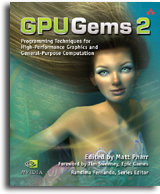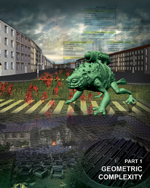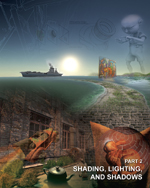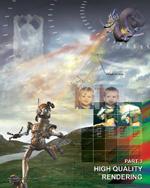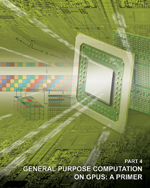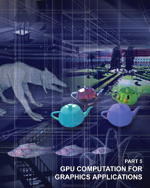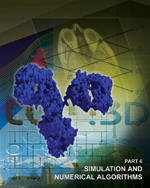

GPU Gems: Programming Techniques, Tips, and Tricks for Real-Time Graphics
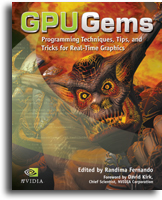 The
winner of Game Developer Magazine's 2004 Front Line Award in the Books category,
GPU Gems
is a compilation of articles covering practical real-time graphics techniques
arising from the research and practice of cutting-edge developers. It focuses on
the programmable graphics pipeline available in today's graphics processing
units (GPUs) and highlights quick and dirty tricks used by leading developers,
as well as fundamental, performance-conscious techniques for creating advanced
visual effects. The contributors and editors, collectively, bring countless
years of experience to enlighten and propel the reader into the fascinating
world of programmable real-time graphics.
The
winner of Game Developer Magazine's 2004 Front Line Award in the Books category,
GPU Gems
is a compilation of articles covering practical real-time graphics techniques
arising from the research and practice of cutting-edge developers. It focuses on
the programmable graphics pipeline available in today's graphics processing
units (GPUs) and highlights quick and dirty tricks used by leading developers,
as well as fundamental, performance-conscious techniques for creating advanced
visual effects. The contributors and editors, collectively, bring countless
years of experience to enlighten and propel the reader into the fascinating
world of programmable real-time graphics.
GPU Gems is hard cover, has 816 pages, and is in full color throughout, with over 300 diagrams and screenshots. It has a suggested retail price of $59.99 and is available at the Amazon, Barnes & Noble, and Addison-Wesley Web sites.
Learn more about GPU Gems in these selected excerpts:
-
Preface
- Contributor
Biographies
- Chapter 3: Skin in
the Dawn Demo
-
Chapter 14: Perspective Shadow
Maps: Care and Feeding
-
Chapter 28: Graphics
Pipeline Performance
Other Useful Resources
Software Development
-
NVIDIA SDK
(2004 Front Line
Award Winner - Programming Category)
-
NVIDIA GPU
Programming Guide
-
Cg Toolkit
Content Creation
-
FX
Composer (2004 Front Line
Award Finalist - Art Tools Category)
-
NVIDIA Texture Tools
-
Melody
Performance Tools
-
NVPerfHUD
-
NVShaderPerf
The latest versions of all these are available at http://developer.nvidia.com.
System Requirements
The system requirements for each chapter's sample vary widely, but for optimal performance, we recommend that you use a Shader Model 3.0-class GPU such as an NVIDIA GeForce 6 Series, NV4X-based NVIDIA Quadro FX, or newer graphics processor. In addition, you may need to upgrade your graphics driver. You will need Microsoft Visual Studio to open up some of the provided projects. OpenGL, GLUT, and DirectX are also required to view all the examples. Many of the executable demos will run only on PCs running Microsoft Windows.
Legal Terms of Use
No Warranty. THE SOFTWARE AND ANY OTHER MATERIALS PROVIDED BY NVIDIA TO DEVELOPER HEREUNDER ARE PROVIDED “AS IS.” NVIDIA DISCLAIMS ALL WARRANTIES, EXPRESS, IMPLIED OR STATUTORY, INCLUDING, WITHOUT LIMITATION, THE IMPLIED WARRANTIES OF TITLE, MERCHANTABILITY, FITNESS FOR A PARTICULAR PURPOSE AND NONINFRINGEMENT.
Limitation of Liability. NVIDIA SHALL NOT BE LIABLE TO DEVELOPER, DEVELOPER’S CUSTOMERS, OR ANY OTHER PERSON OR ENTITY CLAIMING THROUGH OR UNDER DEVELOPER FOR ANY LOSS OF PROFITS, INCOME, SAVINGS, OR ANY OTHER CONSEQUENTIAL, INCIDENTAL, SPECIAL, PUNITIVE, DIRECT OR INDIRECT DAMAGES (WHETHER IN AN ACTION IN CONTRACT, TORT OR BASED ON A WARRANTY), EVEN IF NVIDIA HAS BEEN ADVISED OF THE POSSIBILITY OF SUCH DAMAGES. THESE LIMITATIONS SHALL APPLY NOTWITHSTANDING ANY FAILURE OF THE ESSENTIAL PURPOSE OF ANY LIMITED REMEDY. IN NO EVENT SHALL NVIDIA'S AGGREGATE LIABILITY TO DEVELOPER OR ANY OTHER PERSON OR ENTITY CLAIMING THROUGH OR UNDER DEVELOPER EXCEED THE AMOUNT OF MONEY ACTUALLY PAID BY THE DEVELOPER TO NVIDIA FOR THE SOFTWARE OR ANY OTHER MATERIALS.
Copyright © 2005 NVIDIA® Corporation. All rights reserved. All company and/or product names may be trademarks and/or registered trademarks of the respective owners with which they are associated.
developer.nvidia.com
The Source for GPU Programming

NVIDIA
Corporation |
2701 San Tomas Expressway
| Santa
Clara, CA 95050
|
(408) 486-2000
